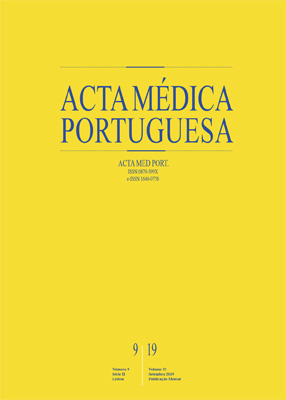Antimicrobial Susceptibility Patterns in Outpatient Urinary Tract Infection in the District of Coimbra, Portugal: A Cross-Sectional Study
DOI:
https://doi.org/10.20344/amp.10862Keywords:
Drug Resistance, Multiple, Bacterial, Portugal, Urinary Tract InfectionsAbstract
Introduction: Urinary tract infections in the community setting are quite common. It is necessary to be aware of antibiotic susceptibility patterns in order to provide rational empirical therapy. The aim of this study is to determine the frequency and antimicrobial susceptibility of the strains responsible for urinary tract infections in primary health care, in the district of Coimbra, Portugal.
Material and Methods: In this observational and cross-sectional study, we analyzed 7134 positive urine cultures of outpatient laboratories in the district of Coimbra, over one year. In most cases, a positive culture was defined by a threshold of 105 colony-forming units per milliliter and was conducted by the automated system VITEK® 2, by bioMérieux. We used descriptive and inferential statistics to determine the prevalence and antimicrobial susceptibility of bacteria and to ascertain whether there were differences associated with sex and age.
Results: From the total of positive cultures, 83.4% pertained to females and 41.0% to individuals over 75 years old. Escherichia coli was the most frequent strain (63.9%), although its prevalence was lower (p < 0.001) in males and individuals over 75 years old. Its susceptibility to fosfomycin and nitrofurantoin was higher than 95% and with ciprofloxacin and trimethoprim/sulfamethoxazole it was lower than 80%. Resistances were more frequent (p < 0.001) in males and in the elderly.
Discussion: Escherichia coli was the most frequent strain, revealing less resistance to fosfomycin and nitrofurantoin. Antimicrobial susceptibility was lower in the elderly and in males, populations in whom empirical therapy may be less successful.
Conclusion: In order to improve clinical results, we recommend periodic surveillance of antimicrobial susceptibility, which could enable the provision of efficient information to clinicians, namely those who prescribe empirically for such infections, as well as standardization of identification methods of bacterial strains diagnosis and of the antibiotic kits to be tested.
Downloads
Downloads
Published
How to Cite
Issue
Section
License
All the articles published in the AMP are open access and comply with the requirements of funding agencies or academic institutions. The AMP is governed by the terms of the Creative Commons ‘Attribution – Non-Commercial Use - (CC-BY-NC)’ license, regarding the use by third parties.
It is the author’s responsibility to obtain approval for the reproduction of figures, tables, etc. from other publications.
Upon acceptance of an article for publication, the authors will be asked to complete the ICMJE “Copyright Liability and Copyright Sharing Statement “(http://www.actamedicaportuguesa.com/info/AMP-NormasPublicacao.pdf) and the “Declaration of Potential Conflicts of Interest” (http:// www.icmje.org/conflicts-of-interest). An e-mail will be sent to the corresponding author to acknowledge receipt of the manuscript.
After publication, the authors are authorised to make their articles available in repositories of their institutions of origin, as long as they always mention where they were published and according to the Creative Commons license.









